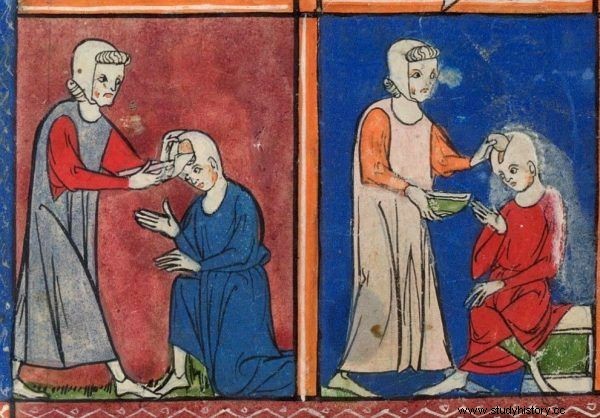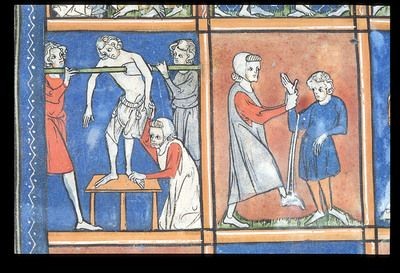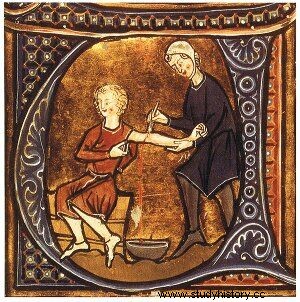When it comes to doctors of the old days, it seems that they were only limited by their imaginations in inventing newer and newer methods of torturing patients. Some ideas used - especially in the Middle Ages - seem so disgusting and pointless that it is hard to believe that anyone would mistake them for medical procedures ...
In retrospect, we can safely say that for most of history, treatment was worse than disease ...
It's better to be happy
John of Gaddesden in his work Rosa Medicinae described the methods of treating mental illnesses. It must be admitted that he was gentle with people for his time.
Bind their limbs lightly and rub the palms and soles of the feet strongly; put their feet in salted water, pull their hair and nose, squeeze their fingers and toes tightly, and make the pigs squeal in their ears. Open a vein on the head, nose or forehead and draw the blood from the nostrils with the hog bristles. Put a feather or straw in their nose to make them sneeze, and burn a human hair or other foul-smelling thing under their noses. Put the feather down their throat and shave the back of their head.
- we read in his book, which dates back to 1314. Could it help? Certainly, the medic achieved one thing:everyone knew perfectly well who had recently been his patient due to a rather specific hairstyle.
Roger Frugard, who lived in the second half of the 12th century, author of Practica Chirurgiae took much more drastic measures against the melancholy. He healed using a hot gold rod that was flexible enough to be able to shape it as needed prior to surgery. The same doctor claimed that it is worth piercing the skull of a depressed person so that "harmful matter" can leave his head.

The working methods of medieval doctors left much to be desired…
The red-hot metals turned out to be a popular tool for many medics. There were even disputes about the date when the procedures should be performed:some believed that it was obligatory to do it in spring, while others were of the opinion that the sick should be burned all year round. The list of diseases "treated" with cauterization was very long:hernia, skin diseases, wounds, excess phlegm, epilepsy or ordinary headaches.
The tendency to sting patients was not only popular in Europe. Abu al-Quasim ibn al-Abbas Al-Zahrawi also recommended cauterization of the head. The procedure was to remove the skin from a specific area of the skull, after shaving the hair. It might not be enough, and in more advanced cases of the disease it was necessary to perform a more complicated procedure:
Burn carefully two places on the rounded forehead, two on the back of the head I was broad, and two points on the temples, one under the lips, one in the dimple on the neck, two under the collarbones and three on the chest, and two more on each the hips and two more under the ankle bones.
The patient had to be strong to experience the shock; otherwise it was not amenable to treatment. Bruno of Longoburgo showed a fairly large dose of common sense, who advised not to keep the hot rod at the skull for too long because the sick man's brain can boil and then the poor man dies.
Urinary controversy
The belief in the healing properties of urine was popular in the Middle Ages and has survived in some circles until today. Even Galen recommended consuming the specially prepared urine of an innocent boy previously mixed in a copper vessel.

Sometimes you get the impression that surviving the treatment was quite a challenge
It seems that urinary fixation was very strong among doctors. Medics tested the samples as they do today for a variety of diseases. It's just that in the Middle Ages the color of urine was determined - three times, in sunlight, distinguishing yellow, green, red, purple and black. On this basis, according to the correlation with the system of planets and stars, as well as the temporary state of the weather, the patient's state of health was determined (of course, nothing resulted, but the doctor did not have to touch him at least).
Dry out of love - literally
For the people of the seventh century, the disease known today as broken heart was a real problem that needed to be treated. It was commonly believed that the cause of love sickness was a dry brain, so it needed to be moistened. Way? The patient was ordered to smell the chosen one's menstrual pads or smoke from her burned faeces.
Matters of sex in the Middle Ages were treated no less specifically and carefully than in other epochs. The author of the home guide, Trotula, who lived between the 11th and 12th centuries, treated intimate topics in a very bold way for her time. She recommended regular intercourse, otherwise a too virtuous woman could be suffocated by a "wild beast" - that is, a "wandering uterus". Following the example of Hippocrates, Trotula recommended preventive measures:sticking burnt wool or foul skin into the nose, and rubbing intimate places with sweet and sweet ointments. However, the matter does not end there. Inhaling the fumes of a boiling old shoe, according to Trotula, helped with too heavy periods . For some reason, which the author of the text prefers never to know, to patients who are struggling with the problem of too much birth of their partner, Trotula strongly advised against using powdered glass. It would appear that women had similar ideas, and the "method" turned out to be too stupid even for its time ...
Random help
Some medications may seem silly at first, but with the state of the art and hygiene at the time, they could turn out to be… surprisingly ingenious and in fact helpful. For example, Roger Frugard, in his 1180 book, described a method of identifying subcutaneous skull fractures:he ordered the patient to bite a nut or plug his nose and mouth and blow. In this way, in fact, the location of the lesions could be revealed, because the patient simply felt pain in a specific place.
Another doctor recommended eating large amounts of bloating food for broken ribs. Effect? The bean-stuffed stomach and intestines stiffened the body and to some extent prevented bad adhesions and punctures.
The primitive and accidentally effective methods of treatment include the use of spider webs, bread and saliva dressings, or bear fat , as well as sealing the edges of the cuts with the heads of ants (the latter method is used in extreme conditions even today, and the addition of animal fats can be found in many ointments that aid healing; cobwebs in combination with saliva and bread secrete an antibiotic).
Guy de Chauliac, Henri de Mondeville's successor and a well-known surgeon, recommended that patients be given chicken broth, which is also an appropriate, or at least harmless, recommendation. He looked for the causes of impotence in the psyche of lovers, and in the event of bed problems, he recommended a series of wine-laden meetings with an "experienced woman"; He loudly criticized gluttony and classified obesity as a serious disease. Remember, however, that the same doctor wanted to eliminate bad breath by rubbing the patient with rabbit blood!
Run away, doctor!
It turns out that in the Middle Ages, methods of treatment were usually based on unsubstantiated superstitions and the juggling of doctors. The problem was, the people who were supposed to help the suffering… had no idea how to do it properly! That is why the famous de Mondeville recommended, first of all, to improve the state of mind of the patient - in this way no one has ever hurt anyone. I must admit that the French had an unusual, sober judgment of his own abilities.

Some of the medications used in history are downright unbelievable!
Among his advice, we can even find recommendations to lay out a bigger lie, maybe write a fake letter about the death of the patient's opponents or about an upcoming promotion at work. Meanwhile, if there was a possibility of not interfering with the patient's body in any way - it was best to use it. One of the medical guides even recommended an easy trick - if the diagnosis was uncertain, it is best to tell the patient that it is the liver . The author of The Doctors Visit wrote:“Suppose you know nothing; say then that it is a liver failure [...] Patients do not understand it, which is very important ".
Maybe that's a good thing. On the other hand, finding an overly ambitious doctor in the Middle Ages was often tantamount to a sentence of a painful and cruel death. A follower of Germanic medicine, the Muslim warrior Usamah ibn Munquidh describes his collision with the reality of the European approach to the sick:
"Then the doctor said," Bring me some strong warrior and give me a sharp ax. " A soldier came with an ax ... Then the doctor put the patient's leg on a wooden block and ordered the soldier to chop off his limb with one blow. He did as he was told, but the leg was not cut off. He gave a second blow and the marrow drained from the limb and the patient died instantly.
Then the doctor examined the woman and said, “The devil is sitting in the head of this woman. Shave her hair. Her mental state deteriorated. Then the medic said, "Satan has penetrated deep into the skull." So he took a razor, made a deep cross in the shape of a cross, tore off the skin, exposing the skull bone, and rubbed salt on it. The woman also gave up her spirit immediately. ”
Bibliography:
- Belofsky, N., How Was Treated Before, i.e. moss fillings and other stories. RM publishing house, 2019.
- E. Herman, Poison, or how to get rid of your enemies in a royal way. Znak Horyzont, Krakow 2019.
- Pilcher, J., Guy de Chauliac and Henri de Mondeville - A Surgical Retrospect. Annals of Surgery, 1895.
